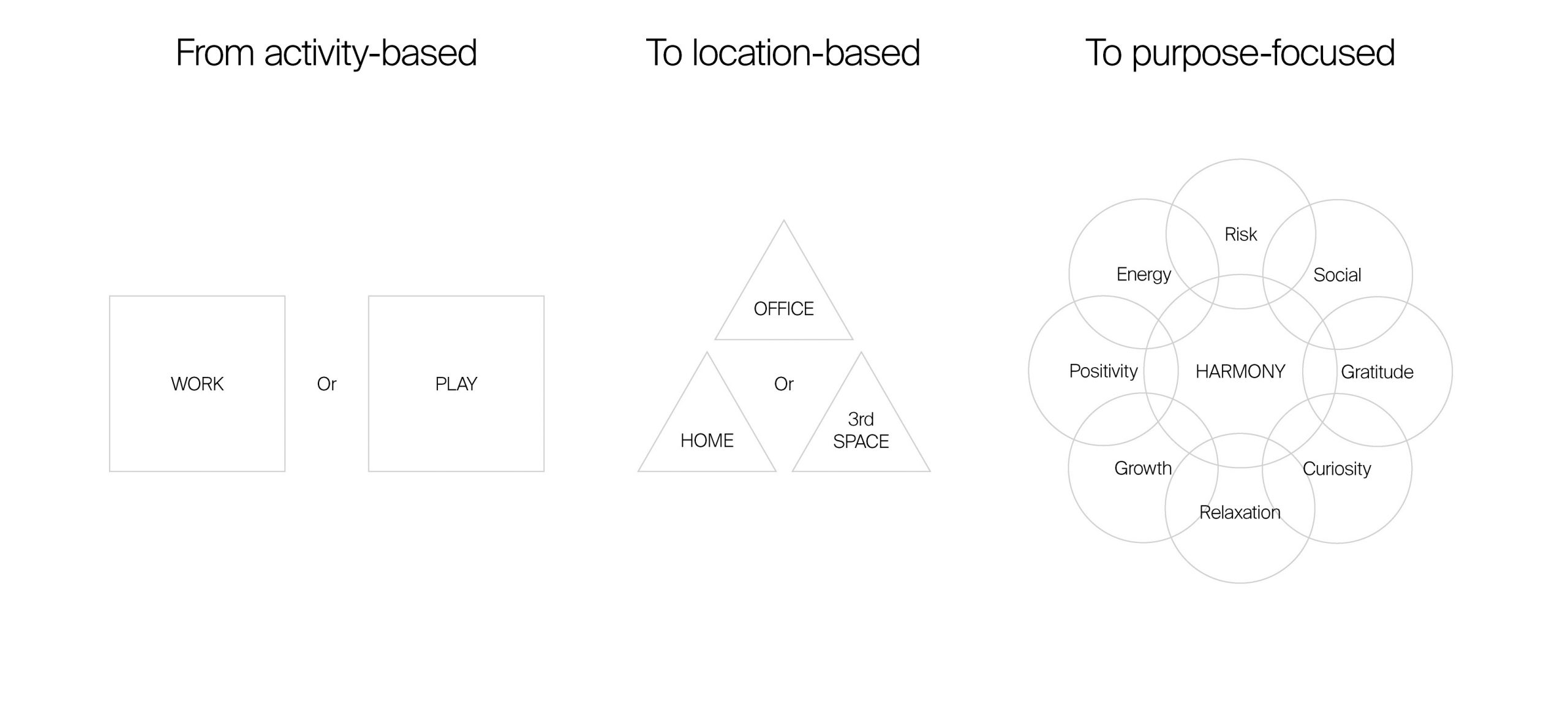In this conversation, between Tom Savigar and Key Kawamura, Eli James and Olivier Terny, we will explore the shift within homes, offices and retail worldwide from activity-based spaces to purpose-focused spaces, based on the experience we have acquired working with international organizations such as McCann World Group, EY or Losinger Marazzi.
The Futurecast: A look forward to the future of purpose-focused spaces
Insights | 29 October, 2021


1 Minute Summary
- The third stage of work culture that is emerging is the ‘purpose-focused space’, which connects people to mindsets and values, not tasks or locations.
- Purpose-focused spaces are all-encompassing and more engaging for tomorrow’s workers.
- They are about inspiring and retaining people and about keeping people identified with the mission and community of an organisation.
- Spatial ecosystems cater to a whole range of needs, decisions, access points and choices.
- It won’t only be physical things like furniture, lighting and furnishings that make a space purposeful
Cascading one’s purpose
In recent years, there has been a noticeable shift towards purpose-focused organisations. The number of certified B Corp companies has tripled in 5 years to 3500, spread across 70 countries. Purpose-focused consumerism continues to grow alongside the buying power of Millennials, and Gen Z. And founders of up-and-coming brands want to engage in business for the good of society as a whole.
“There’s now a lot of momentum towards being a purpose-focused organisation, especially among B2C organisations”, says Eli. “They see the importance of relating better to customers based on why they exist, and more and more organisations are creating workspaces that speak to a purpose. The internal experience for workers has become a differentiator for organisations.”
Indeed, expressing a company’s purpose via purpose-focused spaces is increasingly front of mind for many progressive organisations. “The shift to purpose-focused organisations is something workforces are living and breathing, rather than just saying and selling”, continues Eli. “These organisations are adapting their workspaces based on a rethink of what the workforce is there to do, and how they can do it across diverse digital and physical spaces.”
It seems that workspaces now need to speak to a higher purpose. Declaring a company’s purpose must cascade through an organisation and redefine the perception and expectation of what a workspace is there to do – it’s a higher reason to exist.
“Activity-based spaces are more factual. It’s about what you do, and the space is there to support the action items”, says Olivier. “Purpose-focused spaces are all-encompassing and more engaging for tomorrow’s workers. They are about making sure that the employee relates to the purpose of an organisation and are therefore not only about staff performance and productivity. They are about inspiring and retaining people and about keeping people identified with the mission, with the community of an organisation.”

Maturation of work culture
While the rise of purpose-focused organisations has grown, work culture has gone through three stages of maturity, all of which still coexist around the world today to varying degrees.
“The dominant model today is still the ‘location-based space’, with the traditional desk and meeting room. It is binary; I either sit here or there in my professional universe,” says Key. “Then there is the ‘activity-based space’, which is a model that emerged 30 years ago and reached its maturity in the last 10 years. It is about doing a very focused task, like having conversations, eating lunch, interacting with groups etc. This still happens in a physical compound, and within that compound, there are multiple locations and settings. And what changes from one to the other is a task that you perform”, elaborates Key.
“The third stage of work culture that is emerging is the ‘purpose-focused space’, which connects people to mindsets and values, not tasks or locations. These purpose-focused spaces allow one to optimise their actions, by elevating different mindsets or values that matter to them in different moments of a day,” expands Key.
While activity-based spaces address the bottom part of Maslow’s hierarchy of needs (shelter, quiet, hunger, community etc.), purpose-focused spaces resonate with the middle to higher needs. What is my mission? How do I expand my perception of the world? What is my impact? These purpose-focused spaces will create the conditions for a more enlightened workforce.

Spatial ecosystems
Spaces that support and elevate people’s mindsets and values present an exciting design challenge. Indeed, we’re moving to a time when a whole range of needs, decisions, access points and choices will need to be catered for. Will we see spatial ecosystems emerge that feature many different types of purpose-focused spaces for workforces to choose from?
“There is now more of an emphasis on human idiosyncrasies than ever before. The choice is important, and organisations will succeed by engaging with each employee’s own way of working by providing purpose-focused spaces that relate to all of the communities that people exist within,” says Olivier. “The communities that different spaces belong to matter. For example, when I work from home, the purpose of that space needs to consider family and suit the relationship between the other members of my household and me. But when I work from the studio in Lausanne, the purpose of that space must help me feel the pulse of our company and of the colleagues that surround me.”
This presents a new community dimension to the task of creating an ecosystem of spaces. “In a fragmented spatial ecosystem, full of digital and physical purpose-focused spaces, people will no longer be sitting in a space surrounded by say 50 people and calling that their community”, says Eli. “People will act with purpose in a very transient way, and their state of belonging will change all the time. The concept of community will fluctuate, and we need to design solutions to help people feel connected, even though they are increasingly disconnected from set activities or locations.”

Purpose-focused props
Imagine it is 2025, and your role as an office manager within an organisation is to create a digital and physical ecosystem of purpose-focused spaces. The company knows this move will lead to higher growth, high resilience, and productivity, but the task seems otherworldly.
“I don’t think it is going to be easy to transform into an ecosystem of purpose-focused spaces. Many workers are very used to going to a place of work, to work. This is using location-based spaces,” explains Key. “True, many are beginning to use multiple locations to do different activities, but activity-based spaces are still not second nature to many people. We are only scratching the surface of the potential of purpose-focused spaces. Still, it will see a huge growth as more and more workers begin to identify their own career mindset and values, find organisations that resonate with that set of principles, and expect organisations to deliver spaces that enable them to realise their purpose in the world.”
Where does one start? Are there physical and digital ‘props’ we should use? Technologies will increasingly help people visualise and communicate what’s happening in these spatial ecosystems. New techniques will help people become aware of what’s going on when they use these spaces, of their passive or active states, and importantly track the benefits of using purpose-focused spaces.
“As more and more people use these new spaces, it will be exciting to see how information and knowledge are captured and shared,” says Eli. “This is important because it won’t only be physical things like furniture, lighting and furnishings that make a space purposeful. There are lots of different digital tools that we have at our disposal to understand how our minds and bodies will react in different purpose-focused spaces.”
These digital tools will provide workers with feedback on how their higher need-states are progressing — how they are achieving their personal mission, expanding their perception of the world; and how impactful they are being as an individual and as a collective.

Lateral purpose
As we move into an era of workspaces that are purposeful by design and elicit a higher state of vocation among workers, will it require a far more lateral minded, open-minded and adaptive use of space? And while it will challenge the conventional office, it will also accelerate a better definition of what it means to work from anywhere.
“There is a great need for these new spaces to become the norm,” concludes Eli. “I don’t know whether all organisations will welcome being so open-minded, adaptable, multi-capacitated, but there’s definitely a growing need among workers for incredible amounts of flexibility and versatility.”
“There’s already a high degree of complexity in many organisations. Different locations. Different professions. Different projects. Different rhythms” says Key. “But if what we’re looking for is synchronicity, we’re heading straight into a concrete wall. However, if we accept that diversity and purpose is the game, we should be looking more at harmony to deliver these ecosystems of purpose-focused spaces. Synchronicity means everyone at the same time for the same reason. Whereas harmony means you can be high, and I can be low, and we compensate each other when we meet in a purpose-focused space. But then, when I’m alone in my chosen purpose-focused space, I can explore the outer reaches of what I can achieve as an individual.”
To end on a musical note, this sounds like organisations can deliver ecosystems of purpose-focused spaces and avoid cacophony not with monophony — in other words, synchronicity — but with ‘jazz’. “This is not just a bunch of random people in random purpose-focused spaces coming together to have jam sessions. I think that we can learn a lot from the rules of jazz as a way of orchestrating and navigating the complexity of all these different rhythms and diverse circumstances’, concludes Key.
There is a lot to look forward to in the changing of location-, activity- and purpose-focused spaces, and Studio Banana is constantly experimenting with these new realities. Here are a few thought starters to inspire our next conversation:
– How might your organisation translate its company purpose into the principles for redesigning physical and digital workspaces?
– How might you better understand if your organisation, and your workforce, is ready to shift from location- to activity-, and activity- to purpose-focused workspaces?
– How might your leadership use techniques that create the conditions for open-mindedness and adaptability to this future terrain?
To learn more about the future of purpose-focused spaces, check some other Studio Banana projects:
– Redefining McCann’s culture through a new HQ
– Creating EY’s new capability centre
– Honesty in construction with Losinger Marazzi
